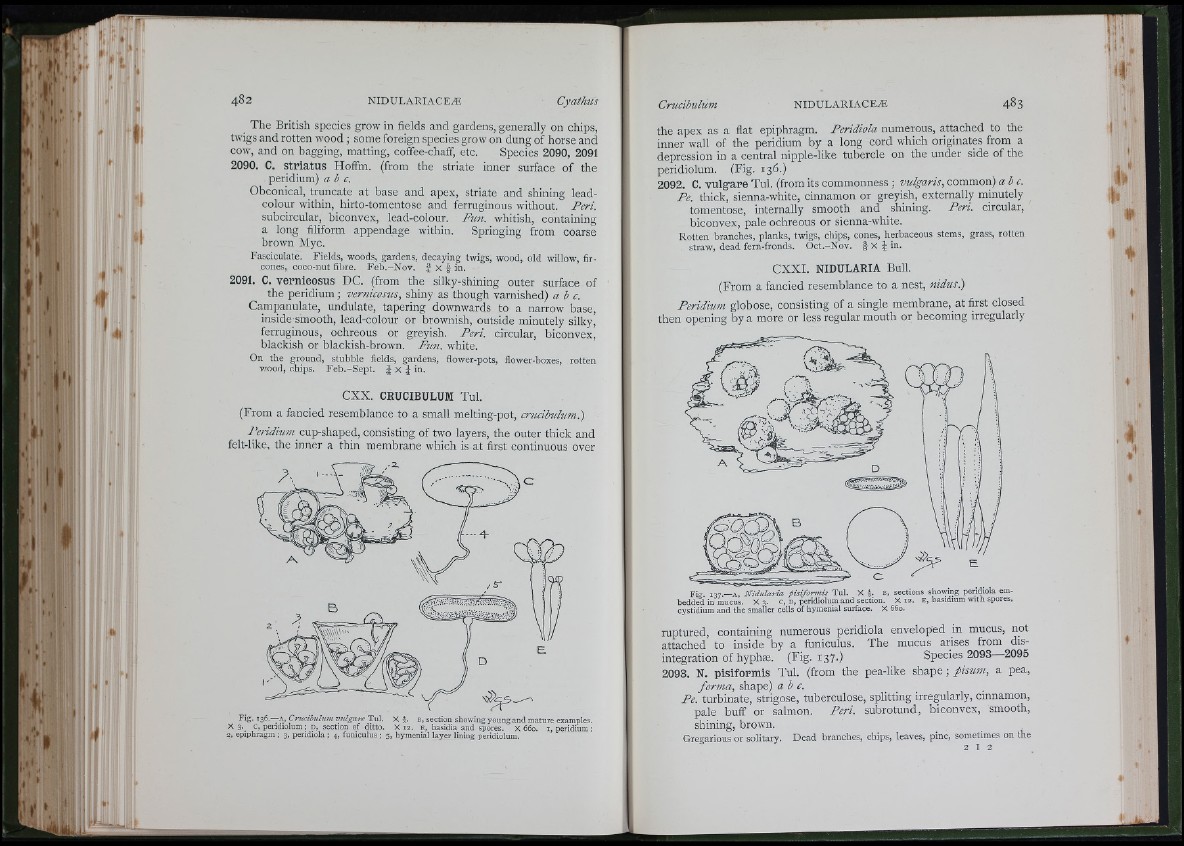
ti í ,
lE
íl
yS.nírii,
482 NIDULARIACEÆ Cyathus
_ The British species grow in fields and gardens, generally on chips,
twigs and rotten wood; some foreign species grow on dung of horse and
cow, and on bagging, matting, coffee-chaff, etc. Species 2090, 2091
2090. C. striatus Hoffm. (from the striate inner surface of the
peridium) abc .
Obconical, truncate at base and apex, striate and shining lead-
colour within, hirto-tomentose and ferruginous without. Peri.
subcircular, biconvex, lead-colour. Fun. whitish, containing
a long filiform appendage within. Springing from coarse
brown Myc.
Fasciculate. Fields, woods, gardens, decaying twigs, wood, old willow, fircones,
coco-nut fibre. Feb.-Nov. f x | in.
2091. C. vernieosus DC. (from the silky-shining outer surface of
the peridium; vernieosus, shiny as though varnished) abc .
Campanulate, undulate, tapering downwards to a narrow base,
inside smooth, lead-colour or brownish, outside minutely silky,
ferruginous, ochreous or greyish. Peri, circular, biconvex,
blackish or blackish-brown. Fun. white.
On the ground, stubble fields, gardens, flower-pots, flower-boxes, rotten
viood, chips. Feb.-Sept. ® x ® in.
CXX. CRUCIBULUM Tul.
(From a fancied resemblance to a small melting-pot, criicibulum.)
cup-shaped, consisting of two layers, the outer thick and
felt-like, the inner a thin membrane which is at first continuous over
Y x g . i f i .—A., Crncthulum vu lgare T n \. X f . b, section showing young and mature examples.
X 3._ c , peridiolum; p, section o f ditto. X 12. e , basidia and spores. X 660. i , peridium ;
2, epiphragm ; 3, peridiola ; 4, funiculus ; 5, hymenial layer lining peridiolum.
Crucibulum NIDULARIACEÆ 4 8 3
the apex as a flat epiphragm. Peridiola numerous, attached to the
inner wall of the peridium by a long cord which originates from a
depression in a central nipple-like tubercle on the under side of the
peridiolum. (Fig. 136.)
2092. C. vulgare Tul. (from its commonness ; vulgaris, common) abc.
Pe. thick, sienna-white, cinnamon or greyish, externally minutely
tomentose, internally smooth and shining. Peri, circular,
biconvex, pale ochreous or sienna-white.
Rotten branches, planks, twigs, chips, cones, herbaceous stems, grass, rotten
straw, dead fern-fronds. Oct.-Nov. | X ® in.
CXXI. NIDULARIA Bull.
(From a fancied resemblance to a nest, nidus)
Peridium globose, consisting of a single membrane, at first closed
then opening by a more or less regular mouth or becoming irregularly
p ¡ „ . 137.— A, Nidularia. p is ifo rm is T u l. X i . B, sections showing pendióla embedded
in mucus. X 3. c , d , peridiolum and section. X 12. e , basidium with spores,
cystidium and the smaller cells of hymenial surface. X 660.
ruptured, containing numerous peridiola enveloped in mucus, not
attached to inside by a funiculus. The mucus arises from disintegration
of hyphæ. (Fig. 137.) Species 2093 2095
2093. N. pisiformis I'ul. (from the pea-like shape ; pisum, a pea,
forma, shape) abc.
Pe. turbinate, strigose, tuberculose, splitting irregularly, cinnamon,
pale buff or salmon. Peri, subrotund, biconvex, smooth,
shining, brown.
Gregarious or solitary. Dead branches, chips, leaves, pine, sometimes on the
2 I 2
l!
i i '
'I
I
! tt'
41«